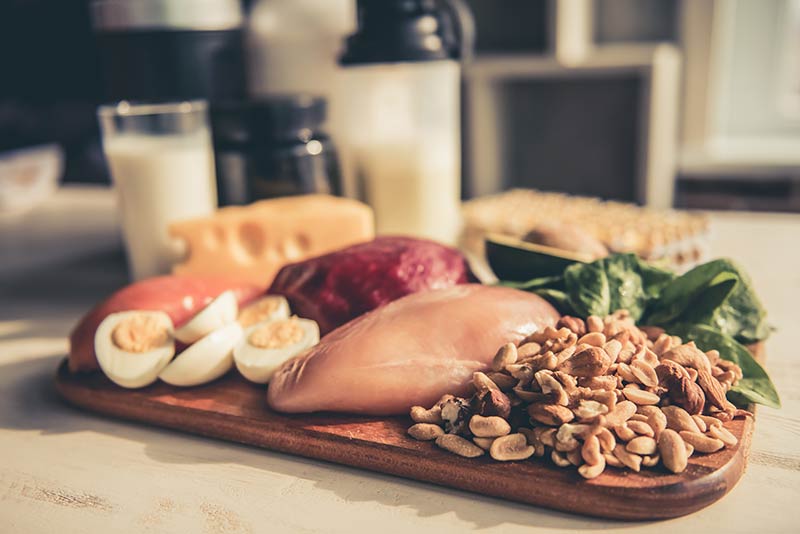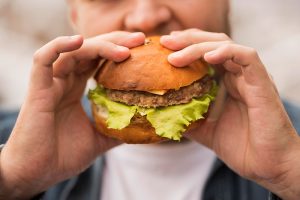We’re all familiar with bulking season. While losing weight is usually the goal for many – not weight gain – bulking is a common cycle for gym-goers looking to get buff.
While there are several ways to bulk up, nobody wants to gain a shed load of fat in the process. Since getting fat is the thing we all want to avoid, a clean bulk is important for gaining muscle in a sustainable, healthy fashion.
But before we dive into how to clean bulk, let’s take a look at clean bulking as a whole.
What is a clean bulk?

In short, bulking requires a calorie surplus – eating more calories than you burn. The aim of the game is to gain weight in the form of muscle or fat, alongside high-intensity resistance training to rocket gains.
A clean bulk – often referred to as a lean bulk – means paying close attention to your calorie surplus to avoid gaining excessive fat.
While many may think that bulking up means eating anything and everything, during a clean bulk it’s all about limiting calorific junk food to promote lean muscle growth.
But is a clean bulk for everyone? Probably not, since the weight gain during a clean bulk can be slower than other bulking methods.
Clean bulking food vs Dirty bulking foods

How does clean bulking food compare to that during a dirty bulk?
When you opt for a dirty bulk, there is nothing you can’t have. Instead of eating clean, you’re allowed to eat whatever you like, packing on as much weight as you can without concern for fat gain.
As we touched upon earlier, a clean bulk may be the slower approach to bulking. So, while a dirty bulk may be incredibly effective for gaining muscle and strength fast, there are also side effects to consider:
- Excess fat gain
- Feeling sluggish
- High cholesterol
- High blood sugar levels
In comparison to a dirty bulk, clean bulking food promotes a controlled calorie surplus with less fat gain, paying close attention to the type of foods you eat.
How to start a clean bulking diet
To kickstart your clean bulk, you’re going to need to know your maintenance calories. This is the number of calories that allow you to maintain your current weight.
Working out your maintenance calories can be done pretty easily, with a range of calculators online to help you estimate this number.
Once you know your maintenance calories, simply add on around 10 to 20% of calorie surplus. As an example: A guy weighing 175 pounds would add around 250 to 500 calories.
To support muscle gain, a daily protein intake of around 0.7 to 1 gram per pound of bodyweight is recommended – while the rest of your daily calorie intake is built up of fat and carbs.
To keep an eye on your bulking macros and daily calorie intake, using a fitness tracking app makes a clean bulking diet far easier.
While weighing yourself frequently can feel a little tedious, it will certainly help you to track your progress. If you’re not seeing the weight gain you’re aiming for, try to bump up your weekly calorie intake by 100 to 200 calories.
Master nutritional intake
In order to put on sufficient weight, you need to nail your calorie intake. Keeping track of your calories can make it easy to see how your food is broken down into protein, carbs and fats.
When we pay attention to these three, making smart choices and seeing food as fuel makes a clean bulking diet more sustainable. If you’re new to clean bulking foods, tracking your progress can help you get started and pay attention to your nutritional intake in fine detail.
If you’re wondering how to clean bulk, try to breakdown your clean bulking foods into the following daily:
- 40% protein
- 30% carbs
- 30% fats
A combination of healthy fats, plenty of protein and carbs provides our bodies with energy – key for reaching your fitness goals. Before a workout, slow-releasing carbs such as brown rice and sweet potato can keep you feeling full and energized.
While carbs can help provide our bodies with energy, protein is key for muscle growth. So make sure you’re getting a healthy mix of all three!
Clean bulking foods to eat (and what to avoid)

Unlike a dirty bulk, clean bulking food focuses on whole, unprocessed foods. While you can have a small amount of high calorie, processed foods, these should be kept to a minimum.
So, what clean bulking foods should you eat? And which should you avoid during a clean bulk? We take a look.
Clean bulking diet: What to eat
- Healthy fats – Such as avocado, nuts, olive oil, chia seeds, flaxseeds, hempseeds, fatty fish and nut butters
- Lean proteins – Think fish, turkey, pork, Greek yogurt, chicken, reduced fat cheese, tofu, tempeh, eggs, egg whites and protein powders
- Fruit – Get plenty of berries, bananas, pineapple, apples, oranges and bananas into your clean bulking diet
- Legumes – Including chickpeas, all beans, kidney beans, navy, black and great northern beans
- High quality carbs – Put down that pizza and try add these high quality carbs into your clean bulking diet: Quinoa, oats, whole grain pasta, sweet and white potatoes and white/brown rice
- Cruciferous veggies – Such as cauliflower, broccoli, cabbage and brussels sprouts
- Dark leafy greens – Including kale, collard greens, Swiss chard and spinach
- Drinks – Plenty of water, seltzer, diet soda, coffee (in moderation!), tea and kombucha
Clean bulk food: What to avoid
Since you know which clean bulk food you should be eating, what should you avoid or limit during a clean bulk cycle?
- Junk foods that are highly processed – Such as fried foods, sugary cereals, chips, fast food, canned soups and stews, full fat ice cream, cakes, cookies, candy, packaged pastries and processed meats like sausage, ham, salami, pate and bacon
- Proteins – Avoid (or limit!) fatty cuts of pork or beef, as well as processed beef sausage and pork
- Saturated fats – Some oils, margarine and butter
- Drinks – Fizzy sodas, sweetened coffee, lemonade and other soft drinks
Getting plenty of rest

Clean bulking food aside, rest periods are just as important for mass gain. If you try to hit the gym daily and lift heavy, you could find yourself overtraining and feeling fatigued. When we feel tired or overworked, it can be easy to feel tempted into eating sugary, processed foods – a no go for a clean bulking diet.
Where possible, aim for around eight hours of sleep each night to give your body plenty of time to recover.
If you’re doing heavy weight training, give yourself regular rest to ensure your body has time to grow muscle and repair itself.
Pairing cardio with a clean bulk
While we all typically do cardio to help us stay fit or to lose weight, some cardio during a clean bulk can help promote cardio health.
Also Read: Dianabol cycling the ultimate guide to Dbulk
While you’re looking to bulk up during your clean bulking diet, avoid high-intensity cardio and instead use low-intensity cardio to warm up or to finish your gym session.
Not only will cardio during your clean bulk help you to burn excess fat, but it will also aid recovery and keep you generally pretty fit.
Include compound movements
Plenty of us often target certain muscles to increase muscle growth in the places we want it most. Although these isolation lifts are perfect as accessory workouts, compound exercises are crucial during a clean bulk.
Sure, your arms might start to get stacked during bicep curls, but compound exercises allow you to train multiple parts of the body in every lift. The more muscles you work during a lift, the more testosterone your body secretes – supporting muscle mass growth.
Plus, you can lift with more resistance during compound movements, which helps promote mass gain.
Don’t bulk for extended periods
As we touched upon early, a clean bulking cycle can’t go on for too long. It’s simply not sustainable in this way. Instead, try to clean bulk for around 4 weeks before assessing your results and choosing whether to continue or not.
While you may be loving the fat loss and muscle gain, your body’s insulin sensitivity starts to decline after 15% body fat – which means it can then become easier to gain fat.
What are the benefits of clean bulking?
When compared to a dirty bulk especially, a clean bulking diet has several great benefits.
Clean bulking foods limit excess fat gain

Unlike a dirty bulk, a clean bulk cycle provides a calorie-controlled approach to bulking – limiting excess fat gain since you’re eating well.
While we all know that you need to be working within a calorie surplus, it’s pretty obvious that whole foods and a lack of junk food are going to support muscle gain – not fatty gains.
When compared to dirty bulking, a clean bulk normally requires fewer daily calories. During a dirty bulk, your calorie surplus can easily exceed 500 extra calories daily.
Reduced health risks
With the right approach to clean bulking foods, eating a varied and healthy diet can lower health risks commonly associated with consuming too many calories.
While living in a significant calorie surplus (during a dirty bulk) may put you at risk of high cholesterol and blood sugar, clean bulking promotes a regulated calorie surplus and the consumption of whole, unprocessed foods.
The side effects associated with a high-calorie diet can vary from one guy to the next, however. Before kickstarting a clean bulk (or even a dirty one), be sure to consider any underlying health concerns first.
Clean bulk = Great nutrition
Since during a clean bulk the majority of your foods are whole, unprocessed foods that are packed with protein, healthy fats and the right kind of carbs – you’ll naturally be fuelling your body with excellent nutrition.
During a clean bulking diet, you can expect plenty of vitamins, fiber, minerals and phytonutrients.
Plus, a diet rich in fiber has been linked to a good digestive system as well as reduced risks of type two diabetes, cancer and heart disease.
Does a clean bulk have any downsides?
While a clean bulking diet may have more upsides in comparison to a dirty bulk, there are a few things to look out for during a clean bulk.
Your progress may slow down

Since a clean bulking diet requires a tightly controlled calorie surplus, there’s room for your bulking progress to slow down.
If you’re new to clean bulking, it can be easy to misjudge your calorie needs, meaning you could cease to gain muscle before you know it.
To avoid this, start with a solid surplus of 350 to 500 calories, keeping track of your progress and weight along the way. Then, you can add more calories gradually if needed to reach your desired weight.
A clean bulking diet is quite strict
While a clean bulk will most certainly benefit your body in a variety of ways, including fiber, vitamins and protein – clean bulking also requires a relatively strict eating pattern.
Being tough on yourself in regards to the foods you can and cannot eat to prevent excess fat and support weight gain can be tricky. With overly processed and sugary foods eliminated completely or kept to a minimum, if you’re unfamiliar with this type of clean bulking diet it can be easy to stray towards foods you can’t have.
Think about it, when we’re on a diet, it’s easy to think about all the snacky foods you shouldn’t be eating – rather than the healthy, nutritious ones you can have.
Also Read: Anadrol side effects – What you need to know
This type of rigid eating plan can be hard to maintain long term, especially when holidays and parties come into the mix!
So, should you clean bulk?
While a clean bulking diet can appear quite restrictive, if you’re new to clean bulking you may need to strike the right balance between a clean and dirty bulk to suit you.
Going head first into a clean bulking diet can feel a little daunting, especially when you’re cutting off processed foods you may be used to eating.
To find a happy medium between a clean bulk and a dirty bulk, dedicate around 90% of your calorie intake to unprocessed, whole foods – while allowing the remaining 10% to be high fat or high sugar foods.
Ready to BULK UP?

If you’re serious about lifting heavy and achieving huge muscle gains, Brutal Force can help you get there.
Our cleverly formulated bulking products are 100% safe and legal, mimicking the effects of popular bodybuilding steroids.
Also, check out our dedicated guide to bulking with step by step instructions on how to bulk effectively and measure your progress.
Ready to push more weight and build muscle FAST?
















